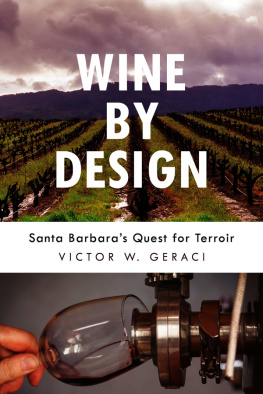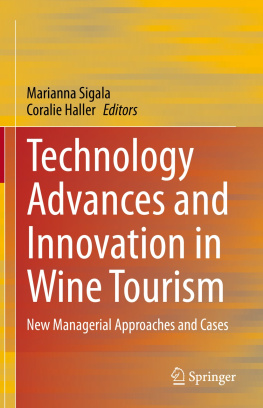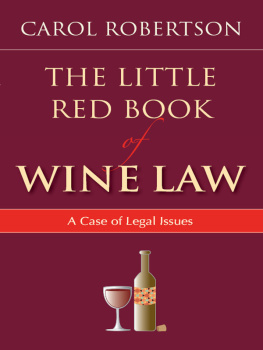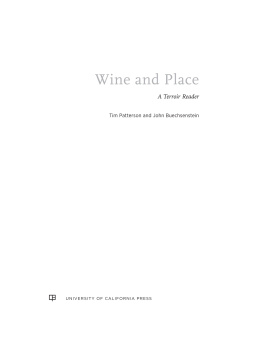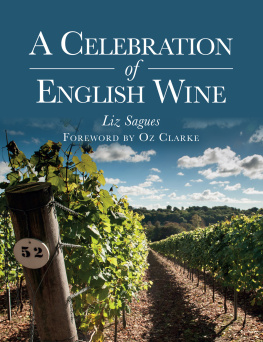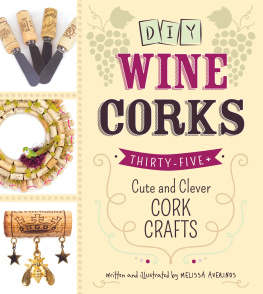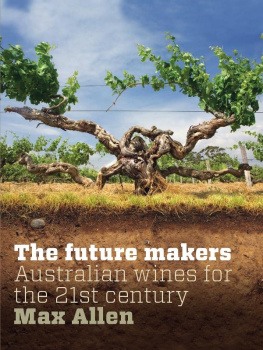University of Nevada Press | Reno, Nevada 89557 USA
www.unpress.nevada.edu
Copyright 2020 by University of Nevada Press
All rights reserved
Cover art Andrei Gabriel Stanescu | Dreamstime.com and Feverpitched | Dreamstime.com
LIBRARY OF CONGRESS CATALOGING-IN-PUBLICATION DATA
Names: Geraci, Victor W. (Victor William), 1948 author.
Title: Wine by design : Santa Barbaras quest for terroir / Victor W. Geraci.
Description: Reno ; Las Vegas : University of Nevada Press, [2020] | Includes bibliographical references and index. | Summary: In the later-half of the twentieth-century the Santa Barbara, California wine industry became a vital part of the global wine community through a process of Wine By Design that utilized science, technology, and agribusiness capitalist tenants. This history, set in the context of nineteenth- and twentieth-century state, national, and global wine history, illuminates a story of how a regional wine industry became part of the national and international wine industryProvided by publisher.
Identifiers: LCCN 2019048354 (print) | LCCN 2019048355 (ebook) | ISBN 9781948908443 (paperback) | ISBN 9781948908436 (ebook)
Subjects: LCSH: Wine industryCaliforniaSanta Barbara CountyHistory. | Wine and wine makingEconomic aspectsCaliforniaSanta Barbara County. | ViticultureCaliforniaSanta Barbara County.
Classification: LCC HD9377.C2 G46 2020 (print) | LCC HD9377.C2 (ebook) | DDC 338.4/7663200979491dc23
LC record available at https://lccn.loc.gov/2019048354
LC ebook record available at https://lccn.loc.gov/2019048355
Manufactured in the United States of America
To all who have shared a bottle of wine with me, and to my grandfather Michaelangelo, who taught my father Victor the ways of the grape grower. He in turn taught the Sicilian ideal of family to my sons Matthew, Gregory, and Damien, and to his great-grandchildren Jordan, Victor, Karime, and Sophia.
Preface
Throughout history grape growers and winemakers have made a Herculean effort to ensure that their consumers had ample supplies of wine for their health, religious ceremonies, celebrations, and mealtime needs. Over time as European explorers came to the New World, they brought their wine culture with them and tried to establish vineyards for local use and to supplement the global wine trade. Often the attempts failed due to climate, pests, diseases, wars, and depressions. But strong cultural wine traditions and continuing demand encouraged vintners to not accept defeat and seek alternatives to make wines better, more plentiful, and profitable. Their answer to increased demand was easily solved by planting more vineyards at home and in their colonial empires. Thus, the early wine industry started a modern trend of meeting market needs by looking for the next new region to grow wine grapes. As their wine-making learning curve grew, they learned to match specific grapes to specific regions and created more efficient and profitable ways to produce, store, market, and distribute wines. In America the quest to establish a wine culture slowly gravitated to the new state of California, where wine entrepreneurs established regions like Napa, Sonoma, Mendocino, Los Angeles, and Santa Barbara.
The wine-by-design theme of this book evolved over twenty-five years of research and writing about viticulture and the history of the Santa Barbara County wine industry.
My 2013 retirement from the Oral History Center provided the opportunity to refocus my work and rethink, synthesize, and expand my research on food and wine. This lead to the publication of my book Making Slow Food Fast in California Cuisine. I now had new contexts in which to frame my earlier work, and reinterpretations of old materials helped put them in a more complex framework. This book is the result of past and new research; but, like all histories, the periodization and original stories leading up to the new history remain somewhat the same. Many of the themes and ideas that run the wine industry today have not changed, while others have evolved to adapt to new circumstances. Wine by Design is not a second edition of any previous work but a new book that utilizes past writings to set the context for a new story of the Santa Barbara wine industry.
WINE BY DESIGN FINDS SANTA BARBARA
Wines journey to the New World began with sixteenth-century explorers and seventeenth- and eighteenth-century colonization that brought European wine ways to the Americas. Despite the optimistic hopes of the new settlers, two hundred years of resolve failed to develop a viable commercial American wine culture. But, determined oenophiles never gave up hope and in the mid-nineteenth century they drew upon the ideals of capitalism and Manifest Destiny to spark a new excitement for developing an American wine industry. Many believed that the West Coast grape-friendly climate and geography finally provided the necessary ingredients for a successful wine industry.
As the American quest for wine reached the new state of California, entrepreneurs quickly took control of the industry and ushered in a new era built on the tenets of Gilded Age agribusiness and by 1900 California dominated the American wine industry. Regretfully, over the next fifty years California wine successes faltered as two World Wars, Prohibition, and the Great Depression again dampened the nations wine hopes.
But the cultural passion for wine and its success as a trade item persisted, and a tenacious generation of entrepreneurs plotted a new course for American wine. Unwilling to give up, wine enthusiasts obstinately continued the wine quest in California and built an industry that from its onset could not keep pace with domestic demand. As the industry came into its own in the latter half of the twentieth century it was bolstered by the new military-industrial economy that allowed for unbridled economic opportunity. The only downside to the California wine success was the fact that over the next five decades growers and vintners failed to keep pace with ever-expanding consumer demands. At first they utilized the tried-and-true solution of simply planting more vineyards. But as cheap vineyard land disappeared, a new cadre of wine businesspeople sought state-of-the-art solutions to boost production and looked to new regions and consolidation to modernize the industry. As a result many began to view regions like Santa Barbara, California as part of the solution.
They shifted from traditional trial-and-error systems to a wine-by-design model whereby wine businesspersons utilized agribusiness techniques dependent upon science, technology, and marketing to achieve both vineyard and winery production goals while maximizing profits. Overall, this California adaptation of the capitalist tenants of agribusiness produced a modern wine industry that first dominated the American market and then became an integral part of the global wine industry.
By the end of the twentieth century the new California style became the global norm and many grape growers and winemakers became industrial capitalists who felt they could produce wine like a widget in a factory. So much so that in 2001 wine businessman and Napa vintner Ed Sbragia boldly told Wine Spectator magazine; I think knowing more gives you more versatility. We can make a wine that fits the profile we want. In Santa Barbara, Alison Green, Firestone winemaker, likened the pursuit to the fashion industry where you have to plan a year ahead for what people want.developing vertical and horizontal business structures, and created new marketing and distribution schemes.
Winemakers, for good or bad, had developed a vintibusiness style that ruled the day. University-trained winemakers and vineyard managers employed new scientific discoveries and quickly learned how to act like megacorporations designed to bring efficiency and consistent quality to wine production.

